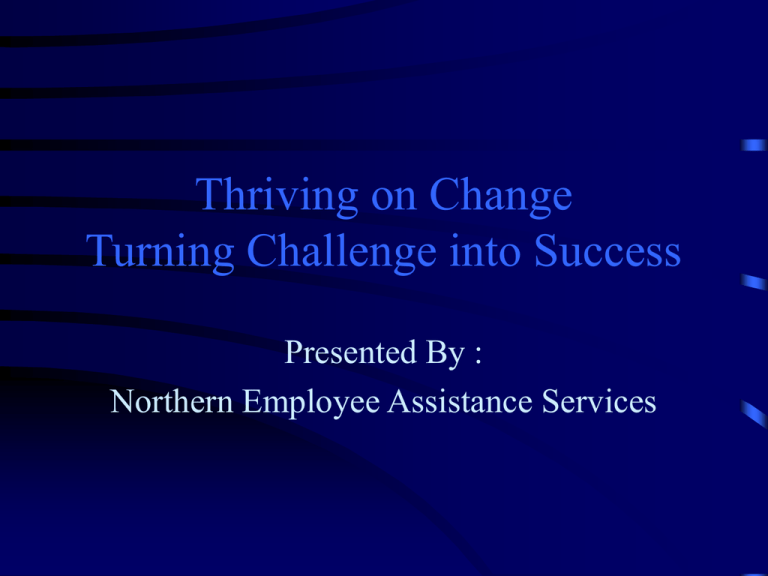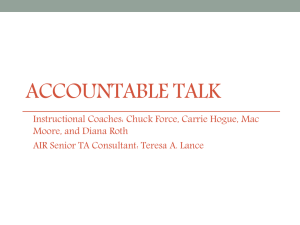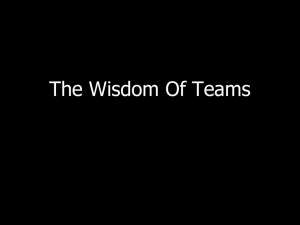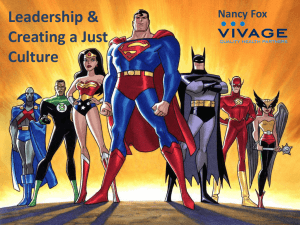Thriving on Change Turning Challenge into Success
advertisement

Thriving on Change Turning Challenge into Success Presented By : Northern Employee Assistance Services Change The only thing we know for certain about the future is that it will bring change. Our History • From 1940 to 1990, we experienced 50 years of change. • From 1990 to 2000, we experienced 50 years of change. • From 2000 – 2005, we will experience another 50 years of change!!!! In the last 10-15 years you have actually lived through 100-150 years of change!! Three Reactions to Change • Reactive • Passive • Proactive The Circle of Change • Change is a reality for every living thing. • Being a problem solver means more change. • The continuous circle of change can not be ignored. Circle of Change Present Change Solution Problem Preparing for Change • • • • • • Why is change needed? Exactly what do you want the end result to be? What is going to change? How do we position the change as positive? Where are we most vulnerable? What are the key success factors in making this work? Organizations don’t change: people do! Five Components of Change • • • • • Strategy Roles and responsibilities Systems and technology Training Common values Change: It’s Not All Bad Change can present excellent opportunities…or serious challenges! Steps to Change • Describe the change What triggered it? What is it’s exact nature? How does the change effect you? Who is responsible for implementation? What monitoring will be done? Recognize the Source of Implementation • • • • Boss or management-imposed System-imposed Customer-imposed Self-imposed Key Conditions that Demand Change • • • • • Technology Prosperity pockets Competition Human capital Individual responsibility Five Steps to Conquer Change • • • • • Resistance Uncertainty Assimilation Transference Integration Step One • Denial • Passive resistance • Active resistance Step Two: Uncertainty • • • • Will it work? Will it leave us behind? Making sure the change will include us. Look for ways it can be used to our advantage. • Lots of questions, few answers. Step Three: Assimilation • Slowly begin to try it. • Confidence builds with familiarity. • We use the change to our advantage. Step Four:Transference • Slowly the new process replaces the old. • As the replacement continues we begin to appreciate the process. • We realize it’s better than the old way. Step Five: Integration • • • • Finally accept the change. Wonder what we ever did without it. Feel in control again. Change has become part of our routine. What Keeps Us Going? • • • • Challenge Personal Satisfaction Rewards Fear One of the changes that incite the most fear in people is the change in the underlying attitudes of an organization. Ask yourself the following: • • • • • • • Can I do this? Am I the one to do this? Should my job be redefined? Is retraining/education available? Is it worth doing? Do we have time? What is the bottom line impact? One of the chief causes of workplace stress is responsibility without authority. Realities of Organizational Change 1) 2) 3) 4) 5) 6) 7) 8) 9) More accountability Greater need for leadership Greater emphasis on teamwork Intense involvement with people Greater ambiguity concerning authority Increased involvement of the whole person Greater emphasis on individuality More stress Continual learning People should expect to • Receive affirmation of their strengths & skills • Receive encouragement for their struggles • Receive rewards for positive contributions In turn they should: • Provide clear leadership where needed • Offer information & advise on subjects in which they have knowledge & expertise • Contribute their own vision & ideas to the organization • Encourage & train those who need assistance The New Managers • People from top are walking around talking to people of all levels • People at the bottom feel safe talking to people of all levels of management & passing on information and ideas • Middle managers as as information conduits to all levels . • People on all levels feel free to approach and deal with problems involving customer service. • Have spending authority over reasonable amounts that reflect the scope of their responsibilities More Accountability • Meet preset goals • Meet performance standards • Be proactive in meeting goals & standards Each person in today’s organization is: • Accountable to the team • Accountable to management • Accountable to self Leaders of today must • Challenge people with a clearly defined vision • Motivate people with internal rewards • Communicate with information and feedback • Listen carefully and constantly Greater Emphasis on Teamwork • Members are: – Accountable to one another – Self managing – Task oriented To be effective • Meet once a week • Work in teams of no more than 15 • Develop their own goals & performance indicators The Fear Driven Employee • Sees change as: – An economic threat – loss of job – A psychological threat – loss of security – A social threat – loss of power or authority Fear Causes • This fear causes them to depend on leadership • They want others to tell them what, how, when, & why to do it. This translates to: • • • • • Lack of initiative Apathy Passivity They become “yes men” Sometimes passive aggressive waste valuable time covering themselves, document to justify existence, eventually burnout Managing a Fear Driven Employee 1) Keep them informed 2) Establish short term goals 3) Measurable baby steps targets for completion 4) Be sensitive to high needs for reassurance 5) Insure they feel part of the team 6) Publicly and privately praise them The Productive Person • Works from a base of security in their abilities • Uses change to increase own productivity • Trusts leadership • Knows they are part of the team • Believes their contribution matters They work best when: • Challenged and motivated to go beyond abilities & outside their comfort zones • Change provides the stimulation that keeps them at their jobs Entitlement Driven Employees • Feel they are entitled to good pay, reasonable job security, stability & routine regardless of their job performance • They put in “face” time, their face is present but their brain & body are not participating in productivity • Main goal is status quo – any changes are suspect • First to resist change • Level of complacency is high • Impact on organization can be devastating in lowered productivity & morale • Play it by the book • Conformity is a protective shell Entitlement Driven Employees avoid: • Assessment – don’t want to set goals let alone measure them. • Measure their work against others meeting standards set by supervisors • Engaging in any kind of performance appraisal How to Manage Entitlement Driven Persons 1) Give specific meaningful tasks 2) Build in opportunity for success – Let them know why their work is important 3) Keep individual accountable for performance 4) State specific goals & expectations 5) Train to ensure full understanding 6) Accept no excuses 7) Conduct regular evaluations 8) Give almost instant feedback to increase motivation 9) Ask for feedback on your assistance 10) Reward effort, skill development & progress They can change, circumvent, reinvent and avoid rules and regulations if it means getting the job done. In other words they are empowered with the authority to meet their goals. Greater Emphasis on Individuality • • • • • Work-sharing programs Flexible scheduling Individual & team goals Training & retraining programs Opportunity for lateral movement Whole Person Involvement • Individuals are asked to make a commitment to the organization through: – Voluntary overtime to finish task – Participation on special task forces or teams – Voluntary education in areas relating to job Reality = More Stress • Increased frustration • Increased Uncertainty • Increased Doubt Continual Training • There is always something new to be learned • What you learned yesterday may be out of date • Only continual learning will keep you in the game • Lifelong learning must become a daily habit Tips for Aspiring Change Agents 1) Be open to imput 2) Network! 3) Actively involve senior management at every juncture 4) Document 5) Learn & share 6) Have no fear 7) Know the business before changing anything 8) Laugh a lot 9) Finish what you start Personal Coping Styles • The Entitled Employee • The Productive Employee • The Fear Employee











